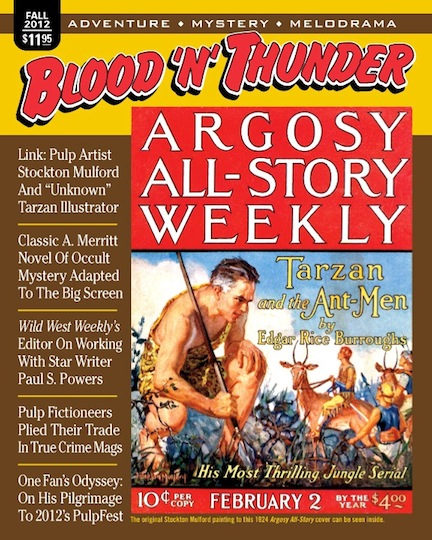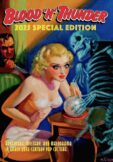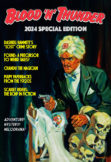EDitorial Comments
Windy City Film Schedule: Saturday
Below are the films that will run on Saturday. Remember, these screenings are not open to members of the public; you have to be a convention attendee. There’s no separate admission charge.
Saturday:
10:00 — Drums of Fu Manchu, Part Two. The action moves to Asia as Fu Manchu races to beat Nayland Smith and his friends to the lost tomb of Genghis Khan. The second half of Republic’s 1940 serial sacrifices some of the first half’s spooky atmosphere but boasts a faster pace and outstanding action sequences, including some lifted from the studio’s 1938 feature film Storm Over Bengal. For the record, our specially prepared cut eliminates repetitive situations from the serial’s last third, which most fans agree was unnecessarily padded.
12:00 — Yours Truly, Jack the Ripper (1961). Few Weird Tales stories have been anthologized more than this Robert Bloch classic, first published in the Unique Magazine’s July 1943 issue. Thriller’s second-season adaptation boasts impeccable credentials: It was scripted by prestigious feature-film screenwriter Barré Lyndon, directed by well-regarded actor Ray Milland, and acted by an outstanding ensemble cast headed by John Williams and Donald Woods (with Boris Karloff on hand as host, of course). The story unfolds in New York, some 70 years after the original Ripper murders. A newly arrived British nobleman believes that Jack is still alive—eternally young as a result of some deal with the devil—and once again practicing his grisly craft in the Big Apple’s sleaziest streets.
01:00 — Masquerade (1961). Henry Kuttner’s blackly humorous short story from the May 1942 number of Weird Tales was the source for one of Thriller’s most memorable episodes. Years, in fact decades later, fans of the series could recall the twist ending even if they couldn’t remember the story’s title or plot details. Tom Poston and Elizabeth Montgomery play a young couple, lost while on their second honeymoon and presumably at the mercy of a family of cannibals running the ramshackle Southern hotel in which they’ve sought shelter. The couple, initially inclined to laugh off their spooky surroundings, accidentally uncover a shocking secret.
02:00 — The Face of Fu Manchu (1965). The first of five Fu Manchu movies produced by Harry Alan Towers and starring Christopher Lee as the Devil Doctor. Towers, who scripted the film under his nom de plume of Peter Welbeck, didn’t adapt a particular Rohmer novel but incorporated bits and pieces from several. Face of Fu Manchu takes place largely in London but was shot mostly in Dublin. As its melodramatic thrills were very much of a piece as those found in Edgar Wallace novels, Towers cleverly cast German actors Joachim Fuchsberger and Karin Dor in key supporting roles; having co-starred in several of their country’s wildly popular Wallace adaptations, they lent considerable box-office allure to Towers’ modestly budgeted film, especially throughout Europe. Although the production values are skimpy—with period detail particularly sloppy and inaccurate—Face teems with action, suspense, and atmosphere. It’s by far the best of the Towers-produced quintet starring Lee as Fu Manchu.
03:45 — The Whisperer in Darkness (2011). Several years ago we ran The Call of Cthulhu, a privately produced, wholly faithful adaptation of H. P. Lovecraft’s epochal Weird Tales story. Windy City attendees who praised that film will be delighted to see this sequel, also made under the auspices of The H. P. Lovecraft Historical Society. Whisperer actually expands on Lovecraft’s original (first published in the August 1931 Weird Tales) while tale while still maintaining fidelity to it. Miskatonic University professor Albert Wilmarth tries to uncover evidence of strange creatures rumored to dwell in a mountainous region of Vermont. The investigation leads him to unimaginable horrors threaten his sanity as well as his life. Very stylish—and stylized—adaptation of a key Lovecraft tale.
Immediately Following Auction — Pickman’s Model (1971). Lovecraft’s terrifying short story, first published in the October 1927 issue of Weird Tales, has been adapted by filmmakers five times to date, most recently last year. This version, which originally aired in 1971 as an episode of Night Gallery, was not only the first version but also the first Lovecraft yarn made for TV. Bradford Dillman, no stranger to troubled young men, plays eccentric art teacher Richard Upton Pickman, whose private studio becomes the scene of unremitting horror when a curious student follows him home. Not as faithful to the original story as subsequent adaptations, this version of Pickman’s Model is not without merit and will make a satisfying cap to our weekend-long salute to Weird Tales on the small screen.
Windy City Film Schedule: Friday
As some of you know, I program the films screened every year at the Windy City Pulp and Paper Expo. With 2013’s convention beginning just eight weeks from today, I thought now might be an opportune time to reveal the titles. The Film Room lineup is generally pegged to each show’s theme, and this year’s Windy celebrates both the 90th anniversary of Weird Tales and the centennial of Fu Manchu, whose exploits first appeared in book form in 1913. Below are the movies and TV episodes scheduled for the viewing pleasure of those fans attending on Friday. The Saturday offerings will follow in my next post.
Friday:
12:00 — Drums of Fu Manchu (1940), Part One. The screenplay for Republic’s 15-chapter serial did not adapt Sax Rohmer’s book bearing the same title; instead it pilfered elements from the entire series, with a special emphasis on Mask of Fu Manchu. Reflecting the studio’s large investment in character rights, Drums was more generously budgeted, and given a longer shooting schedule, than Republic’s previous chapter plays. Added care was taken in scripting, casting, direction, and photography, resulting in what many believe to be the very best of the fabled Republic serials—an opinion shared, incidentally, by its co-director, William Witney. Henry Brandon is ideally cast as Rohmer’s Devil Doctor and character actor William Royle, while not physically suited to the role of Nayland Smith, delivers what is certainly the finest performance of his mediocre career. We are proud to offer a unique presentation of this classic Fu film: a specially prepared feature version, broken into two parts, mastered by us from the only surviving 35mm print struck from the original camera negative. As the print was incomplete, our cut necessarily interpolates some footage from lesser-quality material, and the juxtaposition of sources will prove strikingly illustrative to those who’ve only seen inferior video editions released previously. Another Windy City exclusive!
02:00 — Pigeons from Hell (1961). In addition to the Fu Manchu centennial, this year’s convention celebrates 90 years of Weird Tales, “the Unique Magazine,” which retains its popularity among readers and collectors of classic pulp fiction. In its heyday Weird Tales failed to attract Hollywood filmmakers, who presumably found most of its fare too outré for mainstream audiences. Only a couple yarns from the magazine made their way to the silver screen before 1960; we showed one of them, Fiend Without a Face, a few years back. Weird Tales was far better represented on the small screen, and this weekend we’ll be revisiting some of the best TV versions of popular stories that debuted in the pulp. This 1961 Thriller episode marks Hollywood’s first attempt at adapting Robert E. Howard. Originally published in the March 1938 issue of Weird Tales and called “one of the finest horror stories of the century” by Stephen King, Pigeons from Hell unfolds in and around an old mansion said to be cursed by a malevolent entity. Boris Karloff hosts the episode, which stars Brandon De Wilde and Crahan Denton.
03:00 — Daughter of the Dragon (1931). Having ignored his most famous character for more than a decade, Sax Rohmer was induced to revive the Devil Doctor at least partially in response to Paramount’s widely successful 1929 talkies, The Mysterious Dr. Fu Manchu and The Return of Dr. Fu Manchu, starring a pre-Charlie Chan Warner Oland. By virtue of its previous contract with the author, Paramount retained right of first refusal to the novel that followed, Daughter of Fu Manchu (1930), and promptly optioned the property. However, writer-director Lloyd Corrigan and his fellow scenarists jettisoned Rohmer’s plot and substituted one furthering the revenge scheme that animated the previous two films. Fu’s daughter, Fah Lo Suee, became Ling Moy, and the Doctor himself was killed off early in the proceedings. Nayland Smith was nowhere to be found, the cause of justice being represented by Chinese secret service agent Ah Kee. Rohmer purists are justified in denying Daughter of the Dragon admission to the canon, but the movie is quite engaging in its own right and certainly follows the melodramatic tradition of the author’s best works. Moreover, it’s a good showcase for early Hollywood’s two prominent Asian-American stars: Anna May Wong and Sessue Hayakawa.
04:30 — The Phantom Farmhouse (1971). Back in the day, Seabury Quinn was the favorite author of many Weird Tales readers, and he was perhaps the most prolific as well. Strangely, his adventures of Jules de Grandin—some of which might have made dandy little “B” horror movies—were overlooked by Hollywood. The first of his yarns adapted to film was also his first published in Weird Tales (in the October 1923 issue, to be precise). The Phantom Farmhouse was broadcast early in the second season of Night Gallery, Universal’s well-regarded series of supernatural stories. David McCallum plays the psychiatrist who comes under police questioning when one of his patients is found murdered under mysterious circumstances. Orson Welles, no stranger to dramas of this type, is the narrator.
Immediately Following Auction — The Mask of Fu Manchu (1932). Most Rohmer fans believe this florid melodrama to be the best film featuring Fu Manchu. And it’s hard to make a case to the contrary. The adaptation of the similarly titled novel (already written but not yet published when M-G-M purchased screen rights) hews fairly closely to the source, and the cast is nothing if not noteworthy. Grotesque makeup notwithstanding, Boris Karloff is superbly sinister as the Devil Doctor, Myrna Loy (then typecast as Oriental temptresses) suitably alluring as Fah Lo Suee, Lewis Stone stolidly dependable as Nayland Smith, and future cowboy star Charles Starrett properly heroic as Terry Granville. For many decades after its theatrical release Mask of Fu Manchu was available only in a politically correct version that deleted numerous racially insensitive epithets uttered by the white cast members. Troublemakers that we are, our print restores the offending remarks in all their anti-Yellow Peril glory.
The Windy City Countdown Begins!
Now that 2013 is here, I’m already looking ahead to this year’s Windy City Pulp and Paper Convention. As I write these words the con is scheduled to begin in just 100 days. April 12th will once again find hundreds of pulp-fiction and pop-culture mavens assembling in Chicago’s Westin Lombard hotel for the hobby’s first major event of the convention season. Even though the national economy has been in the doldrums for several years, the Windy City show has continued to grow and thrive, and this year’s confab promises to be another great one.
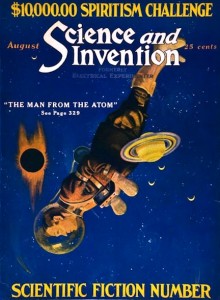 The upcoming “Windy,” as many fans call it, will acknowledge two major anniversaries in the pulp and pop-culture realms. Just 90 years ago, in 1923, pulp fantasy and science fiction took great strides forward with the respective publications of Weird Tales‘ first issue and the special “Scientific Fiction Number” of Hugo Gernsback’s Science and Invention, which paved the way for Amazing Stories and other SF magazines. An even hundred years ago, in 1913, Sax Rohmer’s immortal “devil doctor” made his debut in a book published in England as The Mystery of Dr. Fu Manchu and here in the U.S. as The Insidious Dr. Fu Manchu.
The upcoming “Windy,” as many fans call it, will acknowledge two major anniversaries in the pulp and pop-culture realms. Just 90 years ago, in 1923, pulp fantasy and science fiction took great strides forward with the respective publications of Weird Tales‘ first issue and the special “Scientific Fiction Number” of Hugo Gernsback’s Science and Invention, which paved the way for Amazing Stories and other SF magazines. An even hundred years ago, in 1913, Sax Rohmer’s immortal “devil doctor” made his debut in a book published in England as The Mystery of Dr. Fu Manchu and here in the U.S. as The Insidious Dr. Fu Manchu.
As many of you know, I’m one of the Windy’s committee members, and it’s my job to run the con’s film program, which begins when the show opens on Friday and ends late Saturday night after the auction. This year’s lineup will, naturally, include movies adapted from stories that first appeared in Weird Tales and from Rohmer’s novels. I’m still searching for copies of a few that aren’t commercially available, so I don’t want to tip my hand just yet, but check the Windy City site late this month for the final schedule.
The Windy’s auctions are always highlights and this year’s promises to be no exception. The Friday-night session will include over 200 lots of pulps — some 1100 magazines in all — from the estate of the late, legendary collector Jerry Weist. You can see pictures of many key items on the convention website. Most of these pulps are dazzling high-grade copies and the bidding is expected to be hot and heavy.
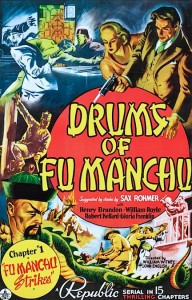 Of course, the Windy dealer room is where most of the action takes place. With over 140 tables of material for sale, there’s always plenty of great stuff for discriminating collectors — even those on tight budgets. As always, Murania Press will be on hand with the latest issues of Blood ‘n’ Thunder and other publications.
Of course, the Windy dealer room is where most of the action takes place. With over 140 tables of material for sale, there’s always plenty of great stuff for discriminating collectors — even those on tight budgets. As always, Murania Press will be on hand with the latest issues of Blood ‘n’ Thunder and other publications.
Stay tuned for updates, but plan on joining us in Chicago. In fact, why not make your hotel reservation today? You can cancel at no cost up to 24 hours before the event, and if you wait too long there’s always a chance that you won’t be able to book a room at the discounted convention rate. (You can find the contact and room-rate info on the Windy’s website.) This show is always one of the year’s highlights, and the next 100 days can’t pass too quickly for me.
Best Wishes For A Happy New Year From The Phantom Empire
Here’s hoping that 2013 will be a happy, healthy, and prosperous year for all friends of Murania. There’s no denying that 2012 was a tough one for many of us, but it’s history now and, with any luck at all, better things lay ahead.
Meanwhile, thanks to all those who took advantage of our Year-End sale, which ended last night. All orders that came in before yesterday have already been processed and shipped, and those who waited till the last minute to make purchases can expect their books in a matter of days.
Also, subscriber copies of the new issue of Blood ‘n’ Thunder are now shipping, the first wave having been mailed last Friday.
This week I finally finish work on The Best of Blood ‘n’ Thunder: Volume Two, which contains well over 100,000 words culled from numbers 11 through 21, the last of the out-of-print issues. Once I get a finished cover from Murania art director Chris Kalb, this one will head to the printer. And H. Bedford-Jones’ The Wilderness Trail, the fourth volume in Murania’s Classic Pulp Reprints series, will follow shortly.
Subscriber Copies Shipping Next Week: BLOOD ‘N’ THUNDER #35
Copies of the new Blood ‘n’ Thunder have started rolling off the press, and the first batch of subscriber copies ships next Monday, with others to follow after New Year’s Day. This issue has been a long time coming (for reasons previously given in this space) but, as always, I’ll believe you’ll find it well worth the wait.
There Are Only A Few Days Left In Murania’s First Year-End Sale!
I’m delighted that so many of you have taken advantage of the first Murania Press Year-End Sale to fill the holes in your collections of Blood ‘n’ Thunder and our other books. All but two or three of the orders placed thus far have already been filled, and the others will ship today or Monday.
To those of you who have not yet taken advantage of the sale but are flush with Christmas cash: You still have a few days left. On Tuesday, January 1st, prices will revert to pre-Sale levels. So don’t miss out on this opportunity to complete your collection of Murania Press books at savings of 20 to 25 percent!
75th Anniversary Edition DVD: Republic’s DICK TRACY (1937)
One of the downsides to being a lover of obscure movies is that, with so many of them either commercially unavailable or lost altogether, you have to settle for whatever you can get: scratchy and splicy 16mm prints, maybe, or bootleg VHS and DVD copies several generations away from the original elements. So it’s almost inevitable that, if you’re seeing a rare motion picture for the first time under these less-than-optimal circumstances, your opinion of it will be adversely affected, if only subconsciously. The die-hard film buff eventually learns to look past, or through, the degraded print; he cultivates the ability to see, in his mind’s eye, the original source material. But this is a subjective and imperfect exercise that yields variable results according to the spectator’s visualization skill.
I mention this because, for many years, I had a rather poor opinion of Republic’s episodic epic Dick Tracy (1937), first of the company’s four chapter plays featuring the comic-strip gumshoe created by Chester Gould. This particular serial, while not uncommon, had never been available in an optically appealing form; the film prints tended to be soft of focus and lacking in contrast, with occasionally watery sound. While I’ve seen much worse prints and video copies, Dick Tracy especially seemed to suffer from lackluster presentation.
The fifth of 66 serials marketed by Republic Pictures in a 20-year period, Tracy was a phenomenal success that made the young studio’s chapter plays competitive with those of Universal, which dominated the sound-serial market up to that point. Nat Levine’s Mascot Pictures had made inroads up to 1935, when it was absorbed into Republic. Levine, who was nothing if not thrifty, didn’t believe in licensing pre-existing properties around which to build his chaptered product; indeed, of Mascot’s 30 silent and sound serials only one—1932’s The Last of the Mohicans—was based on a previously published story, that one having long been in the public domain.
As supervisor of Republic’s chapter-play output Levine was, in a titular sense, the producer of Dick Tracy, although the serial’s day-to-day production fell to his associate Larry Wickland. Based on Universal’s success with episodic adaptations of popular comic strips (two Tailspin Tommy serials, Flash Gordon, and Ace Drummond, up to that point), Republic gambled that it too could strike box-office gold with such a serial. The company paid a handsome fee for screen rights to the Tracy strip and allotted to the chapter play a more generous budget than Levine had ever countenanced for one of his Mascots.
Although the end result was, as I mentioned, enormously popular and profitable, Dick Tracy never enjoyed the approbation that latter-day serial fans accorded its three sequels: Dick Tracy Returns (1938), Dick Tracy’s G-Men (1939), and Dick Tracy vs. Crime Inc (1941). It has been a perennial also-ran. Admittedly, it’s cruder than the sequels, and one prominent fan’s long-ago appraisal of it as “just a Mascot with background music” was not entirely unwarranted.
But now Dick Tracy is available from Oklahoma-based VCI Entertainment as a spiffy new DVD remastered in high definition from original 35mm film elements. Many years ago VCI’s predecessor, United Films, licensed non-theatrical rights to the Tracy serials (which Republic surrendered long ago per contractual obligation) and made them available legitimately in various home-video formats: Beta, VHS, laserdisc, and DVD. But United’s source materials always left something to be desired, with the 1937 Dick Tracy suffering most of all.
I bought the serial—newly remastered and repackaged for its 75th anniversary—last month during VCI’s Black Friday sale. Although a quick preview of Chapter One’s first five minutes left me salivating to see the rest ASAP, I wisely restrained myself, viewing one episode every other day. Last night, following Christmas dinner, I polished off Chapter Fifteen. And I’m here to tell you that I now think better of Dick Tracy than was previously the case. It still trails behind the three more polished sequels but would definitely move up a few notches in my ordinal ranking of the 231 sound serials (assuming I actually had one, that is). And I credit VCI’s presentation with that jump in rank.
The new transfer, seen on a high-def TV, reveals Dick Tracy to be much better photographed than I previously thought it. The extra resolution and improved tonal range makes a big difference, especially in such atmospheric sequences as the first episode’s confrontation between “The Lame One” (the serial’s main villain, also called “The Spider”) and his terrified henchmen. The sound, also, is crisper than it’s ever been; the track has obviously been processed at least a little to remove the hiss and crackling that was audible on 16mm prints of the serial I’ve seen over the years.
I’m tempted to describe other outstanding sequences at length and specify how VCI’s sparkling new transfer enhances them, but I don’t want to spoil anything for those who have never seen this serial. To those who have seen the serial and think it second-rate, I recommend giving it another try via VCI’s 75th Anniversary makeover. Kudos to the guys and gals in Tulsa. This is first-rate work. I’d sure like to see the other Tracy serials remastered from similarly pristine film elements.
Murania’s New Mailing Address
For those of you who would like to take advantage of our Year-End Sale without using the Paypal option of our Shopping Cart function, we have a new address to which you can send checks or money orders. No, the location of Murania hasn’t changed: the Phantom Empire is still thousands of feet under ground, directly below Radio Ranch. But the postman is tired of taking the bullet elevator down and up every day, so our mail now stays in the P.O. for regular pickup by one of the Thunder Riders.
Anyway, you can now address snail mail — checks, letters, money orders, and whatever else — to Murania Press, PO Box 158, Morris Plains NJ 07950. And you should make checks and MOs payable to Murania Press rather than Ed Hulse or Blood ‘n’ Thunder. But ordering directly from the site and using our Shopping Cart function is still the fastest and easiest way to place and pay for your order.
This Year’s Two Top Stocking Stuffers (Provided You Have Big Stockings)
Christmas came a little early this year, and I’m delighted to see that jolly old St. Nick hasn’t lost his touch: He still knows the type of present this good little boy likes to find under the tree. And I suspect most of you will feel the same way about these particular gifts. . . .
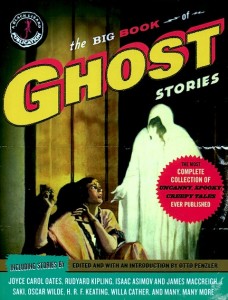 The Big Book of Ghost Stories is Otto Penzler’s latest anthology, and a worthy successor to his Big Book of Pulps, Big Book of Black Mask Stories, and Big Book of Adventure Stories. This jumbo trade paperback reprints nearly 80 yarns in more than 800 pages, and while some are overly familiar (W. W. Jacobs’ “The Monkey’s Paw” immediately comes to mind), many are lesser-known works culled from the pages of pulp magazines. Weird Tales and Ghost Stories are quite well represented, and Otto has pulled additional spine-tinglers from Unknown and Dime Mystery as well.
The Big Book of Ghost Stories is Otto Penzler’s latest anthology, and a worthy successor to his Big Book of Pulps, Big Book of Black Mask Stories, and Big Book of Adventure Stories. This jumbo trade paperback reprints nearly 80 yarns in more than 800 pages, and while some are overly familiar (W. W. Jacobs’ “The Monkey’s Paw” immediately comes to mind), many are lesser-known works culled from the pages of pulp magazines. Weird Tales and Ghost Stories are quite well represented, and Otto has pulled additional spine-tinglers from Unknown and Dime Mystery as well.
In his introduction Otto describes facing a “confounding challenge” in assembling this definitive collection of ghost stories. He argues that an editor compiling such a book just has to include representative works by M. R. James, Algernon Blackwood, Rudyard Kipling, O. Henry, Saki, and other well-known writers of literary merit. There’s no way to avoid all these talents. But he makes up for the inclusion of overly familiar tales by giving over a considerable portion of the book’s “real estate” to such pulp luminaries as H. P. Lovecraft, August Derleth, G. G. Pendarves, Manly Wade Wellman, Arthur J. Burks, Henry S. Whitehead, Fritz Leiber, Paul Ernst, and Wyatt Blassingame, among others. And he has the courage not to include Henry James’ constantly reprinted “The Turn of the Screw,” for which I give him both thanks and praise.
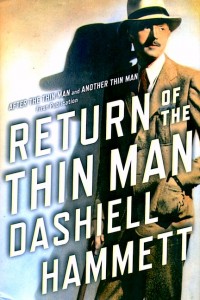 Otto also has a connection—albeit a tangential one—to my second book recommendation of the day, Dashiell Hammett’s Return of the Thin Man. This hardcover was published under Grove/Atlantic’s Mysterious Press imprint, which Otto created and managed for many years. Edited by Hammett biographer Richard Layman and the author’s granddaughter, Julie M. Rivett, the book reprints Hammett’s original “treatments” (also known as “screen stories”) for Metro-Goldwyn-Mayer’s first two sequels to The Thin Man.
Otto also has a connection—albeit a tangential one—to my second book recommendation of the day, Dashiell Hammett’s Return of the Thin Man. This hardcover was published under Grove/Atlantic’s Mysterious Press imprint, which Otto created and managed for many years. Edited by Hammett biographer Richard Layman and the author’s granddaughter, Julie M. Rivett, the book reprints Hammett’s original “treatments” (also known as “screen stories”) for Metro-Goldwyn-Mayer’s first two sequels to The Thin Man.
The treatment is a bastard form, being neither a fully realized screenplay nor a work of polished prose. Basically, it’s an extended outline that cuts descriptive passages to a bare minimum and, in most cases, concentrates on dialogue and incident. Following the surprise success of the first Thin Man picture, M-G-M paid Hammett handsomely to devise new adventures for Nick and Nora Charles. The erstwhile pulp writer, very much enjoying the Hollywood lifestyle, could hardly afford to refuse. His treatments for what became After the Thin Man (1936) and Another Thin Man (1939) were the last long pieces of fiction writing he completed. Introductions and end notes by Layman and Rivett place these works in their proper historical context and add considerably to the history of the Thin Man series. I learned a lot from them.
In addition to the fully fleshed out treatments, the book also contains Hammett’s personal coda to the Thin Man saga, a brief (eight typewritten pages) synopsis to what would have been a sequel to the original novel and movie. It revives The Thin Man’s surviving principal characters but otherwise is a slapdash, lackluster effort that shows how contemptuous of the franchise Hammett had become. Still, it makes fascinating reading.
Both books are highly recommended to fans of pulp fiction.
Recent Posts
- Windy City Film Program: Day Two
- Windy City Pulp Show: Film Program
- Now Available: When Dracula Met Frankenstein
- Collectibles Section Update
- Mark Halegua (1953-2020), R.I.P.
Archives
- March 2023
- July 2021
- May 2021
- March 2020
- February 2020
- December 2019
- November 2019
- October 2019
- September 2019
- August 2019
- May 2019
- April 2019
- March 2019
- February 2019
- December 2018
- November 2018
- October 2018
- August 2018
- June 2018
- February 2018
- December 2017
- October 2017
- September 2017
- August 2017
- May 2017
- April 2017
- February 2017
- September 2016
- August 2016
- July 2016
- June 2016
- November 2015
- October 2015
- September 2015
- August 2015
- July 2015
- June 2015
- May 2015
- April 2015
- March 2015
- February 2015
- January 2015
- August 2014
- July 2014
- June 2014
- May 2014
- April 2014
- January 2014
- December 2013
- September 2013
- August 2013
- July 2013
- June 2013
- May 2013
- April 2013
- March 2013
- February 2013
- January 2013
- December 2012
- October 2012
- September 2012
- August 2012
- July 2012
- June 2012
- May 2012
Categories
- Birthday
- Blood 'n' Thunder
- Blood 'n' Thunder Presents
- Classic Pulp Reprints
- Collectibles For Sale
- Conventions
- Dime Novels
- Film Program
- Forgotten Classics of Pulp Fiction
- Movies
- Murania Press
- Pulp People
- PulpFest
- Pulps
- Reading Room
- Recently Read
- Serials
- Special Events
- Special Sale
- The Johnston McCulley Collection
- Uncategorized
- Upcoming Books
- Western Movies
- Windy City pulp convention
Dealers
Events
Publishers
Resources
- Coming Attractions
- Field Guide to Wild American Pulp Artists
- MagazineArt.Org
- Mystery*File
- ThePulp.Net



